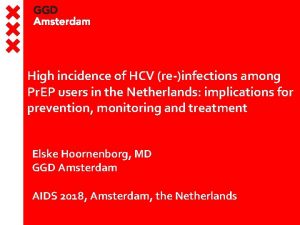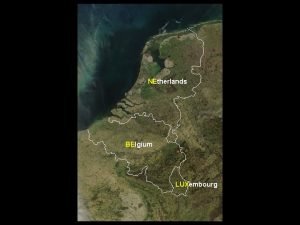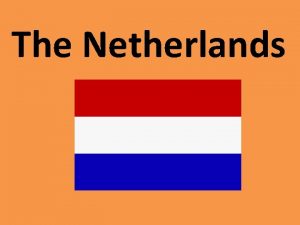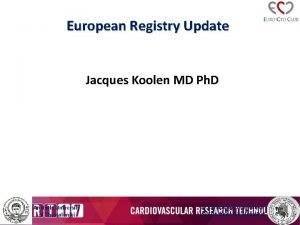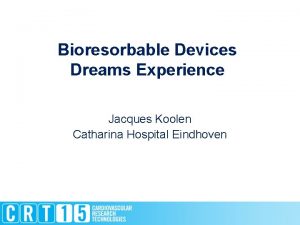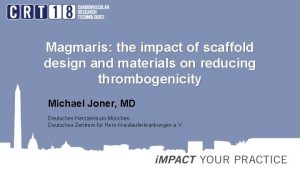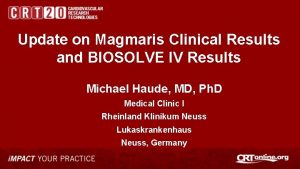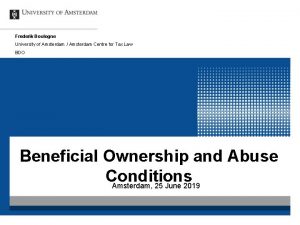Magmaris Jacques Koolen Amsterdam The Netherlands Jacques Koolen













- Slides: 13

Magmaris Jacques Koolen Amsterdam The Netherlands

Jacques Koolen Disclosure Steering committee member Biotronik Speaker s Bureau Medtronic

Why is Magnesium the preferred element for the development of a BRS? Magnesium (Mg) is a common natural element in the human body 1 Magnesium intake • Magnesium is the fourth most abundant mineral element in the body 2 1 cup of cooked spinach Evian water 4 Gerolsteiner water 4 156 mg Magnesium 26 mg /l Magnesium 108 mg /l Magnesium 3 • It is essential for the activity of over 300 enzymes 1 • The total body content is ~ 20 g 1 • 1. 2. 3. 4. The daily intake need is ~ 350 mg Garg et al. Biodegradable and non-biodegr. stents, Minerva Cardioangiol 2009; Arnaud M. Update on the assessment of magnesium status. The British Journal Of Nutrition. June 2008; 99 Suppl 3: S 24 -S 36 Institute of Medicine (US) Evaluation of Dietary Reference Intakes. . Washington, DC: National Academies Press, 1997 Gerolsteiner. de

Evolution of the BIOTRONIK Magnesium Scaffold Device Generation AMS 4 -Month DREAMS 1 G 6 -Month Magmaris 6 -Month 3. 0 & 3. 5 / 15, 20 3. 25 & 3. 5 / 15 2. 5, 3. 0 & 3. 5 / 15, 20, 25 Backbone Mg alloy Refined Mg alloy Strut thickness / width (μm) 165 / 80 120 / 130 120 / 120 (Ø 2. 5) 150 / 150 (Ø 3. 0 & 3. 5 ) Markers none Tantalum composite Coating - drug none PLGA / PTX PLLA / SIR Crossing profile (mm) 1. 6 1. 5 1. 75 Drug elution kinetics n. a. like Taxus like Orsiro Absorption period in months 1 -2 3 -4 (Mg) ≈ 12 (Mg) 0. 83 ± 0. 51 0. 52 ± 0. 48 0. 27± 0. 37 TLF* (%) 23. 8 4. 3 3. 3 Definite-or-probable scaffold thrombosis (%) 0. 0 Kinetics Design Diameter / length (mm) Results In-segment late lumen loss (mm) *Composite of cardiac death, target vessel myocardial infarction, clinically driven target lesion revascularization and CABG

Comparison of in-segment LLL in PROGRESS, BIOSOLVE-I and BIOSOLVE-II Cumulative Frequency (%) 100 PROGRESS (4 -month) BIOSOLVE-I (6 -month) BIOSOLVE-II (6 -month) 80 60 0. 83± 0. 51 0. 52± 0. 48 0. 27± 0. 37 -48% -37% 40 20 PROGRESS vs BIOSOLVE-II: p <0. 0001 BIOSOLVE-I vs BIOSOLVE-II: p=0. 0010 0 -1. 0 -0. 5 0. 0 0. 5 1. 0 Late Lumen Loss (mm) R Erbel et al. , Lancet 2007; 369: 1869 -75, M Haude et al. , Lancet 2013; 381: 836 -44. 1. 5 2. 0 2. 5

Magmaris – key features • First clinically proven resorbable Magnesium scaffold • Compelling safety data 1 • Better deliverability than leading polymeric scaffolds 2 • ~95% of Magnesium resorbed at 12 months 3 1 BIOSOLVE-II 2 Bench testing, BIOTRONIK data on file trial. BIOTRONIK data on file 3 Pre-clinical

Magmaris – the first clinically proven magnesium bioresorbable scaffold Backbone Coating Drug Delivery system Mg alloy Tantalum markers PLLA Limus drug RX, 0. 014” 6 -crown & 2 -link design PLLA degrades ≥ 24 months* 1. 4 μg/mm 2 6 F compatible 150 µm strut thickness and width Proven technology Controlled drug release up to 90 days ~95% of Magnesium resorbed at 12 months *In Raman Spectroscopy at 24 months, the PLLA characteristic peak pattern in the scaffold coating was partially not detectable; however an average signal of the pattern was detected in all samples.

Resorption process of the magnesium backbone Implantation 1 month 3 to 9 months 12 months The graph shows the resorption process of Magnesium with the intermediate steps of Magnesium hydroxide and Magnesium phosphate until the moment where only a footprint (amorphous Calcium phosphate) is left.

Magmaris backbone features: radial resistance and acute recoil Acute recoil Radial resistance Strong radial resistance: Magmaris has no significant diameter change under increasing physiological pressure, whereas leading polymeric scaffold diameter is decreasing under increasing pressure No recoil increase: Conventional leading polymeric scaffold diameter decrease >20% within the first hour Test set up by IIB; BIOTRONIK data on file

Magmaris deliverability: trackability, pushability and crossability Trackability Better trackability in tortuous anatomy: Magmaris has 29% less peak force compared to the leading polymeric scaffold Pushability Better pushability: Magmaris has 34% more force transmitted from hub to tip compared to the leading polymeric scaffold Test set up by IIB; BIOTRONIK data on file Crossability Better lesion crossing: Magmaris needs up to 40% lower lesion entry and crossing force compared to the leading polymeric scaffold

Magmaris shows a rapid endothelial coverage Preclinical test Endothelial coverage at 28 days In a rabbit study, endothelialisation was evalutated with SEM* 28 days after implantation. Higher endothelialisation is associated with a lower thrombosis risk. Rapid endothelial coverage: Magmaris shows 15 % better endothel-ialization compared to the leading polymeric scaffold, especially above struts Magmaris Leading polymeric scaffold *SEM=Scanning Electron Microscope BIOTRONIK data on file

Clinical Outcome until 12 -month follow-up 6 -Month 12 -Month N=120 % N=118 % 4 3. 3 4 3. 4 Cardiac death 12 0. 8 Target vessel MI 1 0. 8 Clinically driven TLR 2 1. 7 CABG 0 0. 0 TLF 1 Definite-or-probable scaffold thrombosis 1. Composite of cardiac death, target vessel myocardial infarction, clinically driven target lesion revascularization or CABG 2. A 58 -year old man (CV RF: smoking, hypertension and hyperlipidemia, stable angina CCS Class II) was treated with a DREAMS 2 G 3. 0 x 20 mm in the distal RCA. The patient experienced an unwitnessed death 134 days after the procedure. Since a cardiac cause could not be ruled out, the independent Clinical Event Committee adjudicated the event as a cardiac death.

Conclusion • Approximately 95% of magnesium of the Magmaris scaffold is resorbed at 1 -year follow-up • In the BIOSOLVE-II trial, there was no definite or probable scaffold thrombosis at 6 or 12 -month follow-up 1, 2 • Cautious use with careful selection of patients and lesions is currently recommended to optimize patient outcomes after treatment with this technology 3 • Magmaris is the first clinically proven magnesium bioresorbable scaffold • Magmaris offers a viable alternative to polymeric scaffold • Ongoing and future studies will better define the role of this bioresorbable scaffold 1. Haude M. et al. Lancet 2016; 387: 31 -9. 2. Haude M. et al. Eur Heart J 2016; 37: 2701 -9. 3. Fajadet J. et al. Euro. Intervention 2016; 12: 828 -33.
 Jacques koolen
Jacques koolen Amsterdam institute of finance
Amsterdam institute of finance Geospatial world forum amsterdam
Geospatial world forum amsterdam Jaap heringa
Jaap heringa Universiteitsbibliotheek singel
Universiteitsbibliotheek singel Một số thể thơ truyền thống
Một số thể thơ truyền thống Amsterdam outline map
Amsterdam outline map Bài hát chúa yêu trần thế alleluia
Bài hát chúa yêu trần thế alleluia độ dài liên kết
độ dài liên kết Diễn thế sinh thái là
Diễn thế sinh thái là Tư thế ngồi viết
Tư thế ngồi viết Bổ thể
Bổ thể Zobair younossi
Zobair younossi Các châu lục và đại dương trên thế giới
Các châu lục và đại dương trên thế giới












